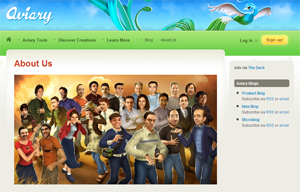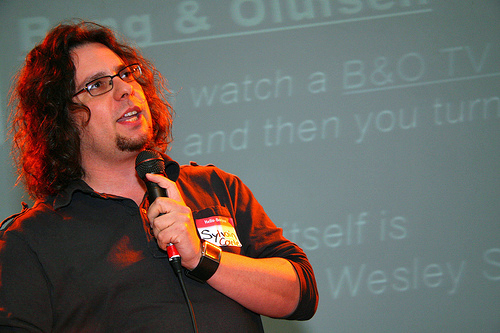05 | Introduction to the Welcome Model
March 8th, 2010 by bruno boutotThe Web is a little like water: in the same way that you have to be in the water to learn to swim, everything on the Web has to be experienced to be understood. #
So I can’t stress enough that I have been able to observe and describe the Welcome Model because I have first personally experienced the consequences of being welcomed, especially by the two persons I am introducing here. #
I had been observing the Web since the early 90s and, as a business journalist covering media and marketing, I was mainly interested in mass media. Around the year 2000, I realized that I should have a better look at the whole variety of native lifeforms that were blooming on the Web. I felt like a gardener who can’t see anything growing in his patch of dirt, turns around and is surprised to find in the nearby wilderness an abundance of new fruits and vegetables. One of the first marvels of the Web is that anybody doing anything on it was only an email away. So I wrote emails asking questions about business models. #
After a few back and forth exchanges, Avi Muchnick told me that I had better experience his website from the inside and asked me to register. He was creating at the time Worth1000.com, a website hosting daily contests of image manipulation. I didn’t know anything about “photoshopping” as we said at the time, but Avi told me to poke around. I had the privilege, at the advanced age of 53, of becoming a newbie. #
I began to participate in comments and forums. I made all the the basic mistakes, I was bullied, I bullied back and was almost banned by an upset admin. But I survived. I learned. I was fascinated. As soon as I realized how this “community” machine worked, I knew that I had reached the promised land: I had been an editor in chief of magazines, and I saw that “mods” and “admins”, the people operating communities, were the editors in chief of this world. That’s why I called my blog modadmin, for the editors in chief of Web media. #
Avi Muchnick – photo by Joi Ito
I became a juror (Worth1000 jurors had then editing powers), and once again I made all the basic mistakes, like editing an ongoing thread and being accused by angry members to try to change the past. This was an exhilarating time: the site was running and changing all the time. There were new contests in photography, text, illustration, animation. Admins were as much creative in governance solutions as members were with their artworks. We were all trying new things, exchanging, experimenting. It was as thrilling as what I had experienced when launching magazines or a daily newspaper, only faster, more intense – and with less pay :-). Avi was 23 years old, studying law, making a living designing web sites, marrying, having a kid, while spending nights coding the site with Israel Derdik. Nowadays, they are developing Aviary. #. #
. #
I was an old hand stumbling on every molehill while surrounded by whiz kids, talented artists, young geniuses having other jobs but all knowledgeable about programming. I still didn’t know anything about manipulating images nor about coding but Avi and the admins welcomed me in their midst. I will eternally be grateful for their warm welcome: they left me wander among them with access to every possible button governing the system. Avi gave me the keys of the house. And the whole time, I was taking notes and developing the observations that became ComCom and media machina. #
Professionally, those years at Worth1000 gave me the confidence to tell to media people that it is not that difficult to interact directly with registered members; there is a logic to it, steps to implement, guidelines to write, tools to install, but community building works. More importantly, I was at Worth1000 in daily contact with real people: I saw tempers flare, emotions rise and ebb, dramas, hilarity, recklessness, compassion, fun and hate, laugh and tears. I was touched by individuals and I was touching them. This is also an important professional lesson for media people: Web communities are not mass media, they are places where only real people can interact, one by one. #
While I was in contact through Worth1000 with people all over the world, back in Montreal I was not very successful when trying to convince my colleagues in media and marketing that we should build communities for their users and consumers. I had no more luck with local programmers until I met with Sylvain Carle, now CTO of Praized Media and needium. As A Frog in the Valley, he had been one of the first bloggers and he became the first person in my own city who knew at once how media and communities could come together. #
Sylvain Carle – photo by Simon Law
Sylvain is a coding genius and the social hub of every kind of geek camp or conference about programming, about the Web, about identity, about social media, about local marketing, about open everything and mobile anything. We spent long hours pushing the ComCom observations first into a business model and then into an architecture for prospective clients. I’ll tell later in these pages how it went and why it went that way. #. #
. #
At the same time Sylvain introduced me to the Web community of Montreal, where I was mainly known as a magazine guy. He led me to the Yulblog and Yulbiz events, made me a blogger of the first Webcom conference and an admin of the Webcamp events ever since. He also helped me play with Drupal and WordPress, insisted that I try facebook and he even registered my first account on Twitter. We live in incredible times and I am incredibly lucky to have met such a great and generous friend. #
If you think that the linked images above are ads, you are wrong: ads are anonymous and have barely any content. These links lead you to two real people who have welcomed me, with whom I have created memories, and the stories I have just told about them convey trust. #
And trust is the supreme currency on the Internet. #
This is how “welcoming” sums up the real difference between traditional media and communities on the Web, between mass communication and personal relationships. #
#







